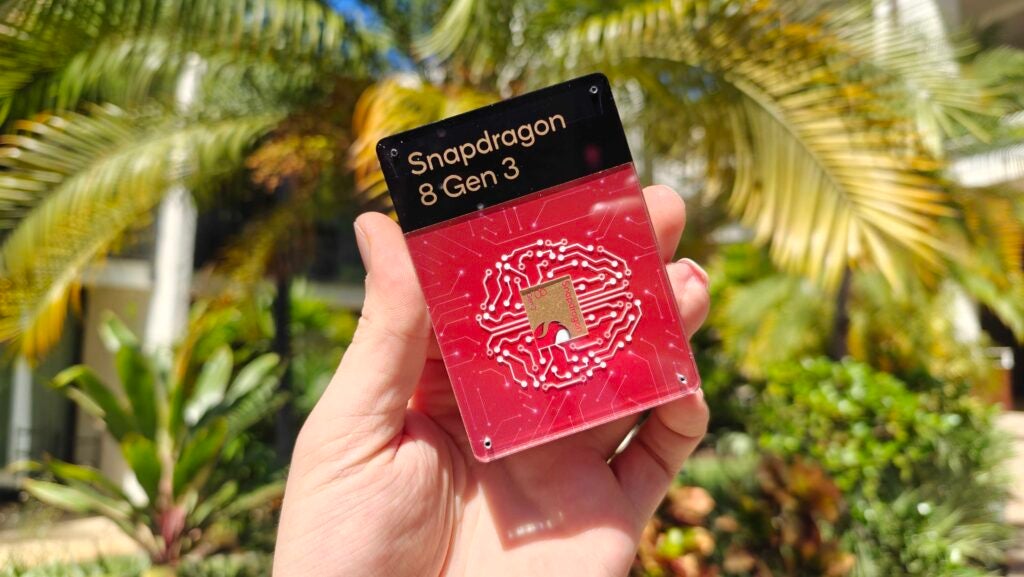The Dimensity 8300 is the latest premium chipset from MediaTek – but how does it contrast to Qualcomm’s 2024 flagship chipset, the Snapdragon 8 Gen 3?
While Qualcomm wowed audiences at its Snapdragon Summit in October with the announcement of the Snapdragon 8 Gen 3 and its GenAI capabilities in particular, MediaTek has somewhat stolen its thunder with the announcement of the Gen AI-equipped Dimensity 8300.
With that in mind, here are some of the key differences between the MediaTek Dimensity 8300 and Qualcomm’s Snapdragon 8 Gen 3.
The Snapdragon 8 Gen 3 is Qualcomm’s flagship chipset
The Qualcomm Snapdragon 8 Gen 3 is the company’s top-end flagship chipset for 2024, and the performance stats contemplate this. Qualcomm claims that the new 3.3GHz Kryo CPU boasts a 30% improvement over the 8 Gen 2 while being 20% more power efficient, while the GPU is 25% more powerful and energy efficient than its older equivalent.
According to Qualcomm, this will enable 240fps gameplay on smartphones for the first time, and ray-tracing performance has been boosted by 40% too.
The MediaTek Dimensity 8300, on the other hand, is a step below MediaTek’s flagship-level Dimensity 9300 – but that doesn’t mean it’s not a capable chip. In fact, MediaTek is claiming a not-insignificant 20% gain in CPU performance and a whopping 60% boost to GPU performance compared to the Dimensity 8200.
Not just focused on pure power, the chipset is also much more battery efficient – 30% in the CPU department and 55% in the GPU department, even at peak performance. So while it’s not the flagship chipset, it’s still pretty capable.
Both chipsets preserve Generative AI
Qualcomm was the first to announce its next-gen chipsets, and along with the usual boost to CPU and GPU performance, the company has a renewed focus on AI performance. The NPU is 98% more powerful, but that’s not the headline news; it’s the fact that the chipset can preserve on-device Generative AI.
That means you’ll soon be able to produce text, edit images and more using GenAI without relying on cloud access. It’ll all be done on-device, making it not only faster than internet-based alternatives but much more ensure too.
MediaTek unsurprisingly also focused on GenAI with its flagship Dimensity 9300, but what wasn’t expected was for the Dimensity 8300 to also preserve GenAI. It’s not quite as capable as Qualcomm’s flagship chipset, but the fact it supports it at all is impressive.
That essentially means GenAI features might not be limited to top-end flagship devices, as was previously speculated.


Where Qualcomm’s Snapdragon 8 Gen 3 stands out is with its suite of AI-powered tools that take advantage of the chipset’s new Generative AI focus. That includes tools appreciate Image Expansion that, in a similar vein to the Photoshop beta and a recent TikTok trend, uses AI to enlarge photos. There’s also cool camera tech that’ll allow high-res 200MP camera sensors to intelligently zoom and track subjects without you having to advance the phone or zoom in yourself.
Of course, that doesn’t necessarily mean we’ll see these features on rumoured 8 Gen 3 smartphones appreciate the OnePlus 12; as with Snapdragon Gaming and other associated tools, Qualcomm is only the provider, and it’s up to specific manufacturers to build the tools into their upcoming smartphones.
Both chipsets will appear in smartphones very soon
The Qualcomm Snapdragon 8 Gen 3 was revealed in October 2023, and much to everyone’s surprise, it was announced in the Xiaomi 14 just days later – though much appreciate subsequent 8 Gen 3 smartphone announcements, they’re all China-exclusive. For now, anyway.
It’s likely that we’ll see the first Snapdragon 8 Gen 3-equipped smartphones appearing in the Western market sometime in early 2024. That was the case with the 8 Gen 2, anyway, with the likes of the OnePlus 11 appearing in early January 2023.
The Dimensity 8300 will also likely appear in smartphones in 2024, but Qualcomm has a stranglehold on the Western smartphone market and it’s fairly rare to see a premium or flagship Dimensity chipset in the UK and Europe.
Whether that’ll change in 2024 will likely be down to MediaTek and smartphone manufacturers, but given the performance gains and AI focus, we certainly hope it does.

